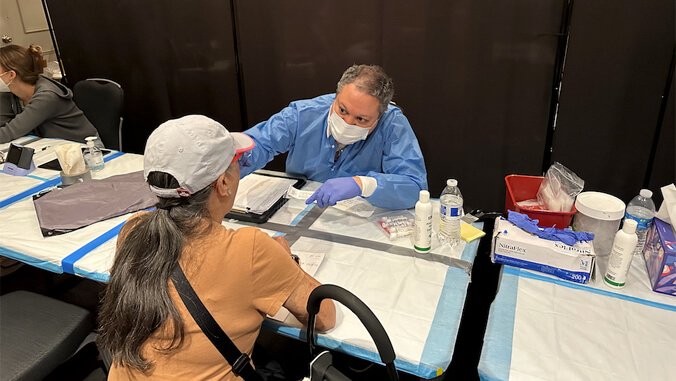Nearly two years after the devastating August 2023 wildfires, new findings from the largest post-disaster health study in Hawaiʻi’s history—led by the University of Hawaiʻi—paint a complex picture: steady progress in some areas of recovery, but continued health and housing challenges, particularly for children and vulnerable groups.
Now following 2,000 adults and children, the Maui Wildfire Exposure Study (MauiWES) shows encouraging trends in emotional healing and expanded access to health insurance. However, the latest data also reveal persistent physical and mental health burdens, as well as stark warning signs among the newly enrolled cohort of children—whose struggles underscore the urgent need for pediatric care, trauma-informed services and long-term investment.
Data collected from the full cohort of 1,800 adults through January 2025 echoed 2024’s findings and revealed the long arc of recovery. Overall, 42% of adults report worse health compared to the previous year. Half show depressive symptoms, 26% report moderate-to-severe anxiety, and 4.2% have had suicidal thoughts in the past month. Meanwhile, 74% have elevated or hypertensive blood pressure, and more than a quarter show reduced lung function.
While insurance coverage has improved significantly—with fewer than 10% now uninsured—access to care remains a persistent barrier. About one in three participants report difficulty scheduling appointments or getting prescriptions, especially for chronic and respiratory conditions.
About 41% of adults are still living in temporary housing, and 25% remain unemployed but actively looking for work. Despite these struggles, 61% report high levels of support from family and friends—demonstrating the continued strength of community bonds.
Children in the MauiWES study show signs of physical healing, but their emotional well-being raises serious red flags. More than half (51%) of children ages 10–17 screen positive for depression, with 22% in the severe range. About 30% report anxiety symptoms, and nearly 45% still show signs of PTSD—8% at severe levels. One in four report low self-esteem, and many are experiencing functional challenges at school and home.
One in three children had elevated or high blood pressure, with Filipino youth most affected—16% falling into Stage 2 hypertension. Nearly 20% of children have impaired breathing capacity, especially among Asian and Filipino children. Girls show slightly more severe lung issues.
According to the report, these findings point to the need for sustained investment in pediatric care, trauma-informed school services, clean indoor air and culturally tailored mental health programs. Without early intervention, these risks could become lifelong health burdens.
Among the 1,800 adults enrolled in MauiWES, one-year follow-up data is available for 424 participants. Within this group, experts are seeing meaningful signs of recovery. Reports of worsened health dropped from 48% in year 1 to 36% in year 2. Suicidal thoughts declined by nearly half, and rates of severe depression and anxiety fell significantly. These improvements suggest that emotional healing is underway for many.
PTSD remains widespread, affecting nearly one in three participants. Physical health indicators—such as blood pressure and lung function—have worsened for many, pointing to gaps in long-term care. Access to health insurance has improved dramatically, with the uninsured rate cut in half thanks to outreach efforts and programs. Many residents—especially in rural areas—still struggle to get the chronic and respiratory condition care they need.
Nearly half of participants are still in temporary housing, and food insecurity is a common concern. Yet community resilience shines through: most participants report strong support from family and neighbors—underscoring Maui’s strength, solidarity and determination to heal.
Maui is recovering—step by step, community by community. The data suggest that while the road to full recovery remains long, meaningful progress is underway. Strategies such as outreach-driven health insurance enrollment, trusted community partnerships, and culturally rooted social support have helped many residents regain stability. At the same time, long-term challenges such as chronic physical health conditions and trauma recovery as well as permanent housing needs require renewed investment and attention.
“As stability improves, deeper psychological effects are surfacing,” according to the report. “Ongoing longitudinal tracking is therefore critical to keep a pulse on these shifts, build on the trust we’ve earned, and ensure that locally grounded strategies continue to foster healing, resilience, and a healthier future for all.”
See more UH News stories on MauiWES.
Congrats UH Mānoa spring 2025 commencement
Have a story idea or a question?
Contact news@hawaii.edu
If required, information contained on
this website can be made available in
an alternative format upon request.
Get Adobe Acrobat Reader
About
Calendar
COVID-19 Updates
Directory
Emergency Information
For Media
MyUH
Work at UH
English
Gagana Samoa
Kapasen Chuuk
Lea faka-Tonga – Tongan
Tiếng Việt
ภาษาไทย
Ilokano
Tagalog
Cebuano
Kajin Majôl
简体中文
繁體中文
日本語
한국어
Español
ʻŌlelo Hawaiʻi
